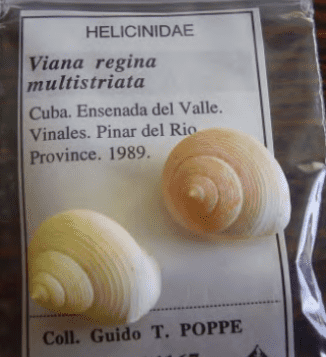
Taxonomic revision and natural history of Viana regina (Morelet, 1849): Their exhibition and divulgation (2008-2011)
&
Taxonomic revision and natural history of the Cuban terrestrial mollusk Emoda sagraiana (Orbigny, 1842): Helicinidae: Gastropoda (2012-2013)
Internship details
2008, 2009, 2010, 2011, 2012 and 2013
Royal Belgian Institute of Natural Sciences
Dr. Backeljau Thierry, Dr. Samyn Yves and Dr. Van Goethem Jackie
Animalia – Mollusca – Gastropoda – Cycloneritida – Helicinidae – Viana/Emoda
2008-2011 internships:
The Phylum Mollusca represent, after the arthropods, the most numerous group within the Animal Kingdom. The Cuban archipelago counts 1300 species of mollusks and more than 105 subspecies. They have a high diversity of taxonomic forms, numerous species are characterized by microlocalization, and most of the species are endemic (98%). This zoological group is of great importance because of its role in the ecological balance of ecosystems and because it contains a considerable number of species that are of direct interest to humans (plague, vectors of diseases, food, biological controls and bioindicators).
Taxonomic studies on mollusks are very rare in the country; most of them are in the field of ecology and biotechnology. This is due to the fact that Cuba doesn’t have many taxonomists dedicated to mollusks (not many taxonomists in general). Furthermore, it is important to mention that the specialized literature in Cuba is very scarce and dispersed. In the past, taxonomists classified the animals based on their forms and external appearance (phenotype); later they saw that other internal characters could be very important in separating or joining species. Today, with the technological advances and the development of science, research is also focusing on the molecular level (DNA). However, we cannot forget that the final expression of genes is altered by the environment; that is why we should study both the genetic and ecological characters of the organism.
This project concerns the taxonomic revision of Viana regina (Morelet, 1849), an endemic species of western Cuba. It is a very charismatic species due to its characteristic color pattern. According to some authors the genus is monospecific whereby V. regina is made up of three subspecies. The present project aims to revise the taxonomic status of these three subspecies. In a first phase the available literature on this taxon will be assembled and studied. In a next phase, fresh material of the three operational taxonomic units will be collected and studied through comparative anatomy. A genetic study of the three subspecies will also be carried out by analyzing the genes 12S, 16S, CO1 and Cyt B.
2012 & 2013 internships:
There are many important localities in Cuba with a very high endemism of terrestrial mollusks. We must mention Viñales Valley as a very special area because in the past it was one of the most visited by naturalists. There are 134 species reported for Viñales Valley with 65% local endemism. Many of these species were described based on external characters like form and height of the shell, colors, collumela form, protoshell, form of lips and mouth, etc. Only phenotype was used in those years, but after 1953, with the discovery of DNA by Watson and Crick, taxonomic science changed forever.
The family Helicinidae contains 11 genera and 75 species. The genus Emoda (H. et A. Adams, 1858) comprises 14 species. Emoda sagraiana is the only species that lives in Pinar del Rio and there are seven localities with different phenotypes. That’s why it is very important to perform molecular studies and compare with the genus Viana.
Discover more about this GTI project by:
viewing the poster that Ms. Herrera Uria presented at the World Congress of Malacology in 2013 (Azores) going through this presentation explaining the purpose of Ms. Herrera Uria’s 2008-2011 internships (presented at RBINS on November 27, 2009)